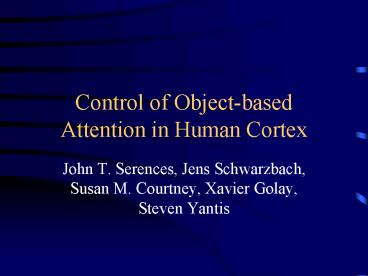Control of Objectbased Attention in Human Cortex - PowerPoint PPT Presentation
1 / 23
Title:
Control of Objectbased Attention in Human Cortex
Description:
... region : the recipients of attentional biasing signals and not the source of ... of behavioral goals and are a likely origin of attentional biasing signals. ... – PowerPoint PPT presentation
Number of Views:48
Avg rating:3.0/5.0
Title: Control of Objectbased Attention in Human Cortex
1
Control of Object-based Attention in Human Cortex
- John T. Serences, Jens Schwarzbach, Susan M.
Courtney, Xavier Golay, Steven Yantis
2
Introduction
- Two distinct aspects of selective can be
distinguished occipital and temporal cortex,
parietal and frontal cortex. - Three domains of selective attention have be
documented space-based attention, feature-based
attention, object-based attention. - Studies of the effects of attention have both
behavioral facilitation and enhanced cortical
responses to attended locations or features. - Posterior parietal and frontal cortex as crucial
for the control of spatial attention and
feature-based attention.
3
Introduction
- All the attributes of an attend object are bound
together into a unitary representation. - Superimposed stimulus spatial selection is not
possible. - Face and house stimulus, which maximally active
distinct anatomical foci in ventral visual
cortex. - Embedded within the morphing stimulus stream were
targets that directed the subject to shift
attention between the face and house stream or to
maintain attention on the currently attended
stream.
4
Exp. 1
- Subject 15 young adult
- behavioral task hold targets(2), shift
targets(2) Fig. 1 - Data acquisition and analysis BOLD, fMRI
- Eye position monitoring To evaluate the
possibility that switch-related activity was
related to overt or covert shifts of spatial
attention.
5
(No Transcript)
6
Exp. 1
- Results
- behavioral data No significant differences in
the behavioral detection rates for the shift and
hold targets or in response time. - attention effects in localizer ROIs right
lateral fusiform gyrus(face), medical fusiform
gyrus(house) Fig. 2(a-d) - BOLD data Fig. 2(e-g) Table 1
- a markedly different temporal pattern right
lateral fusiform, medical fusiform gyrus.
7
(No Transcript)
8
Exp. 1
- Results
- shift-related activity In frontal
cortex(superior frontal sulcus, precentral
gyrus), in parietal cortex(medial aspect of the
superior parietal lobule and left intraparietal
sucleus), left lingual and fusiform gyri, left
occipital pole, left lihgual and fusiform gyri.
Fig. 3(a-f) - BOLD data medial SPL, precuneus-IPS, righ
SFS-PreCeG and the left lingual-fusiform gyri.
Fig. 3(g-i) - The timecourse of the BOLD signal lateral
fusiform, medical fusiform gyrus
9
(No Transcript)
10
Exp. 1
- Results
- Fig. 4 (left superior frontal gyrus, near the
left intraparietal sulcus) - Table 2(the difference in the BLOD response
to shift face to house and hold house is larger
than to shift house to face and hold face events) - eye movements (the mean number of eye
movement,eye gaze, stimulus identity,shift versus
hold) no difference
11
(No Transcript)
12
Discussion
- Posterior parietal and dorsal is a role in
object-based attentional control. - Occipital and ventral temporal visual region
the recipients of attentional biasing signals and
not the source of such signals. - BLOD data In medical fusiform gyrus, an
increasing response to shift face-to-house
targets. - The present cannot be ruled out solely with eye
movement. - Subjects may have been attending to the
roof-line of the house stimuli and the
eye-noise-mouth region of the face stimulus.
13
Exp. 2
- Subjects 8 young adult
- behavioral tasks hold targets(2), shift
targets(2) Fig. 5 - data acquisition and analysis BOLD, fMRI
- eye position monitoring To evaluate the
possibility that switch-related activity was
related to overt or covert shifts of spatial
attention.
14
(No Transcript)
15
Exp. 2
- Results
- behavioral data detection accuracy higher for
shift versus hold target, no other significant
effects were observed for detection rates or for
the response time. - attention effects in localizer RIOs right
lateral fusiform(the interaction between stimulus
identity and time) , medical fusiform
gyrus(house, the interaction between stimulus
identity and time). Fig. 6
16
(No Transcript)
17
Exp. 2
- Results
- shift-related activity medial SPL-precuneus,
right SFS-PreCeG(Table 4, Fig. 7) - eye movements (the mean number of eye
movement,eye gaze, stimulus identity,shift versus
hold) no difference
18
(No Transcript)
19
Discussion
- Transient activation increase in regions of
dorsal parietal and frontal cortex that are
commonly thought to mediate voluntary control in
other domains. - The main effect of shifting attention observed in
SPL and SPS-PreCeG regions, there was a main
effect attention to houses. - The house stimuli were reduced in size so that
they overlapped with the eye-nose-mouth region of
the face stimuli, which corresponds to the region
of space most relevant for discriminating faces.
20
Discussion
- Eye movement data collected in the scanner
revealed no difference either in the number of
eye-movements made following shift and hold
events. - The study can be attributed to the control of
object-based, and not space-based, attentional
control.
21
General Discussion
- Frontal cortical areas are intimately in the
maintenance of behavioral goals and are a likely
origin of attentional biasing signals. - The posterior parietal cortex participate in
controlling non-spatial object-based attention. - The present data do not rule out the possibility
that parietal and frontal regions are the
recipient of attention-related changes in
extrastriate visual area.
22
General Discussion
- Mechanism of attentional control the study
found that parietal and frontal areas are
transiently active during shifts of attention
between objects functionally similar parietal
areas were found in previous studies of spatial
attention shifts. - The present results suggest a dual role for
parietal and frontal regions in attentional
control involving the initiation and the
maintenance of a desired attentive state.
23
Conclusions
- The dorsal frontal and parietal cortex mediate
nonspatial shifts of object-based attention. - The functional similarity of the neural systems
associated with shifts of spatial and
object-based visual attention suggests a
domain-general mechanism of attentional control.































